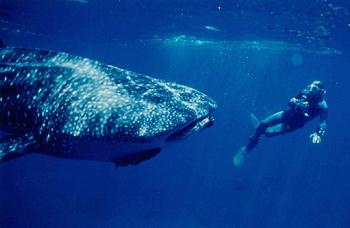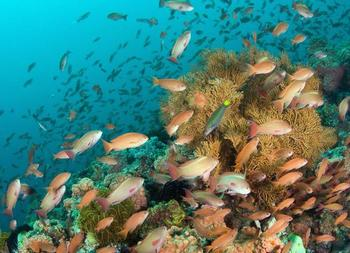 科學家發出警告表示,佛得角島通道(Verde Island Passage),一條在菲律賓狹窄的熱帶水域迴廊,被認為是全球最多樣化的海洋生態系正面臨氣候變遷的威脅,人類必須立即對其採取保護的行動。
科學家發出警告表示,佛得角島通道(Verde Island Passage),一條在菲律賓狹窄的熱帶水域迴廊,被認為是全球最多樣化的海洋生態系正面臨氣候變遷的威脅,人類必須立即對其採取保護的行動。
上週科學家聚集在菲律賓的八打雁市(Batangas City),參加一個由總部設在華盛頓特區的國際保育組織(Conservation International)所主辦的工作坊。與會者在評估氣候變遷對佛得角島通道的影響後,對於其前景表示憂慮。
佛得角島通道的海洋生物物種密度比世界上任何地區的海洋都來得高,包括鯨鯊(學名為Rhincodon typus)、巨硨磲蛤(Tridacna gigas)和最具代表性的泗水玫瑰(Pterapogon kauderni)。
但小組的科學家們警告說,氣候變遷的影響加上人類過度竭力開發資源的行爲,證實已經威脅到海洋生物的棲地。
他們發現,海洋溫度上升造成珊瑚白化 -- 這意味著許多依附珊瑚生存的動植物將無法再繼續仰賴珊瑚。
科學家還表示,海平面上升造成珊瑚溺水的現象。這是因爲隨著水深越深,珊瑚的生長也因此受到抑制。
另外,海平面上升也破壞了紅樹林 -- 一個重要的沿海棲地,它扮演維護海岸線和防止沿海社區免於風暴的侵襲、緩解洪水造成的影響和提供了未成年魚類重要的棲地等功能。
更高頻率和強度的風暴也波及海洋以及沿海棲地和當地的旅遊業。
 珊瑚變得越來越容易受到氣候變遷的相關因素所帶來的威脅。諸如海洋溫度上升、海平面上升和海洋吸收溫室氣體二氧化碳而變得更偏酸性。酸化的海水不利於珊瑚骨幹的生長。
珊瑚變得越來越容易受到氣候變遷的相關因素所帶來的威脅。諸如海洋溫度上升、海平面上升和海洋吸收溫室氣體二氧化碳而變得更偏酸性。酸化的海水不利於珊瑚骨幹的生長。
政府官員和當地居民也加入科學家們的行列,討論環境的變化、當地社區如何受到影響,以及需要採取何種因應的措施等問題。
科學家們建議採取多重保護該地區的措施,包括確保海草床、紅樹林和將其他扮演重要生態棲地的區域,都列入保護區内。
他們還建議推行替代生計,如海藻養殖以及將港口用樁架建在水面上,讓沉積物得以自由流動,以至於降低堆積的沉積物對珊瑚和其他沿海海洋生態系的傷害。
The Verde Island Passage, a narrow corridor of tropical waters in the Philippines that is considered the most diverse marine ecosystem in the world, is at risk of climate change and needs immediate protective action, scientists are warning.
The scientists gathered last week in Batangas City, Philippines for a workshop organized by Conservation International, which is based in Washington, DC. After assessing the impacts of climate change on the Verde Island Passage, they painted a grim picture for the unique area.
The Verde Island Passage has the highest concentration of marine species of any region in the world's oceans, including whale sharks, Rhincodon typus, giant clams, Tridacna gigas, and the iconic Banggai cardinalfish, Pterapogon kauderni.
But the panel of scientists cautioned that the impacts of climate change in combination with over-exploitation of resources already are threatening the marine habitats.
They found that increasing ocean temperatures are causing coral bleaching - meaning that corals can no longer support the array of plants and animals that rely on them.
Sea level rise is causing coral drowning as the water gets deeper and coral growth is inhibited, the scientists say.
Sea level rise is also damaging mangroves - a key costal habitat that protects the coastline and coastal communities from storms, reduces the impacts of floods and provides important habitats for juvenile fishes.
And increased storm frequency and intensity is affecting the marine habitats as well as coastal settlements and the tourist trade in the area.
Corals are becoming increasingly vulnerable to climate related threats as ocean temperatures increase, sea level rises and the ocean becomes more acidic as it absorbs the greenhouse gas carbon dioxide, a process that undermines corals' ability to grow their skeletons.
The scientists were joined by government officials and local people who discussed the changes in the environment, how the local community is being affected and what needs to be done to adapt.
The scientists recommended a series of measures to protect the area, including ensuring that seagrass beds, mangroves and other habitats that provide important ecological services are included in protected areas.
They also recommended the promotion of alternative livelihoods such as seaweed farming for area residents, and construction of ports on stilts to allow sediments to move freely, reducing sediment loads that harm corals and other coastal marine ecosystems.







